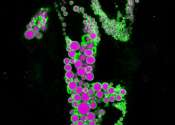Fatty tissue surrounding intestinal tracts of mice found to help eject gut-infesting worms
A team of researchers at the Max Planck Institute for Immunobiology and Epigenetics, working with colleagues from the Washington University School of Medicine, the Medical University of Vienna, the Van Andel Research Institute ...









